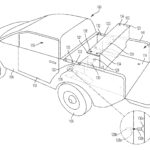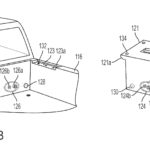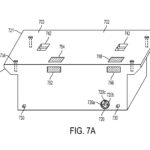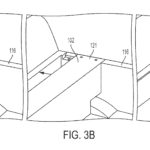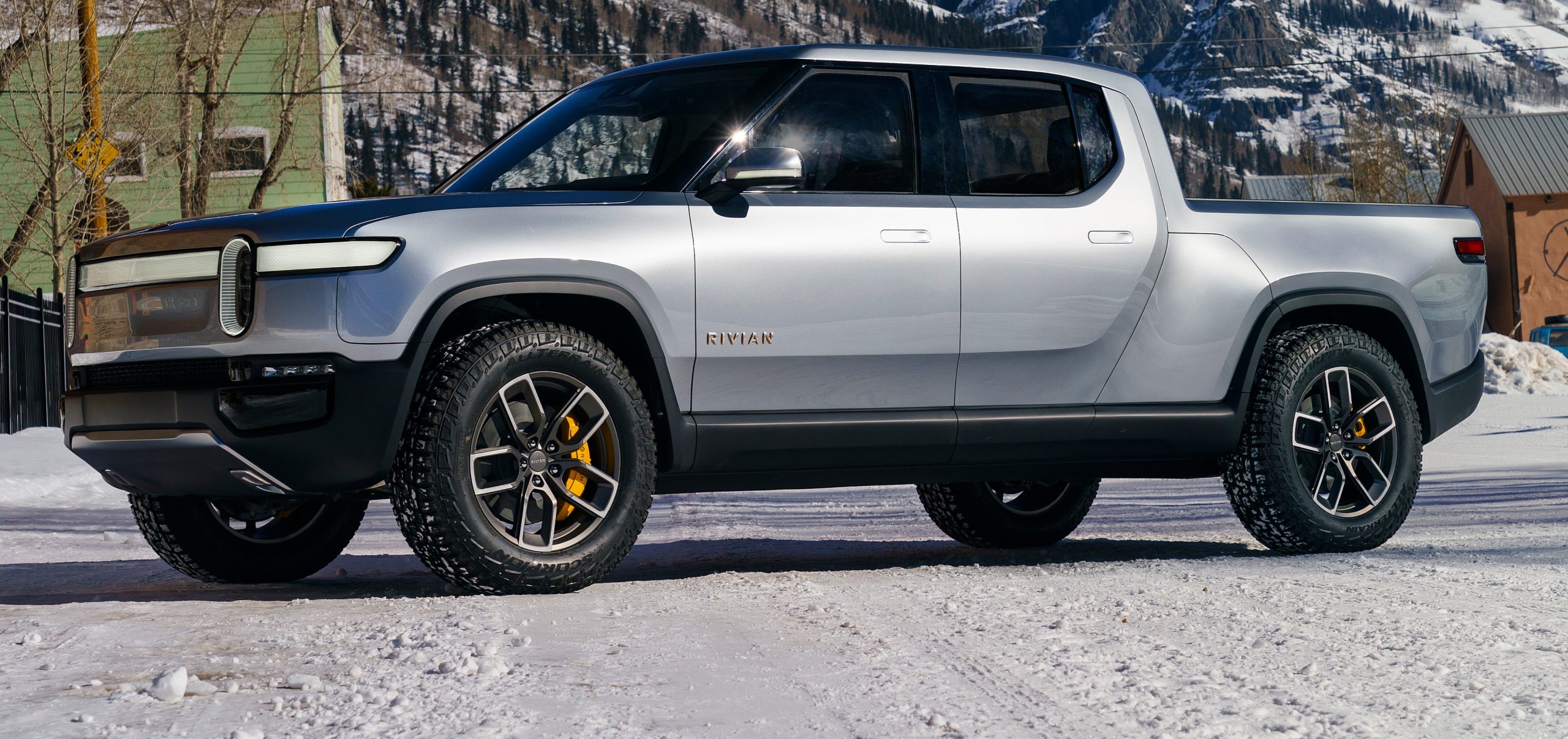
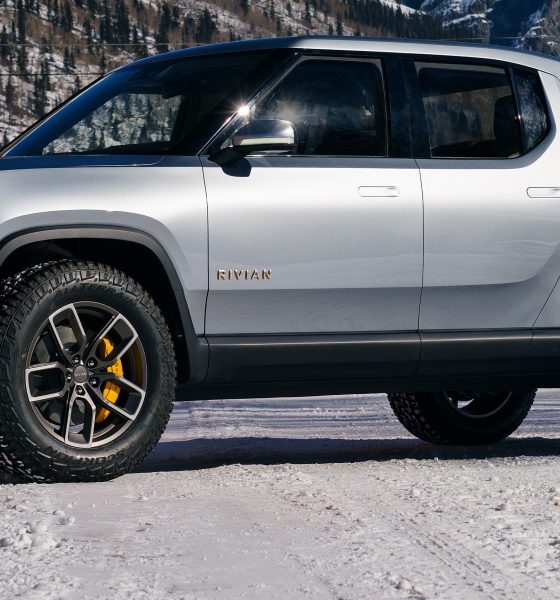
News
Rivian patent reveals R1T auxiliary battery that pushes range beyond 400 miles
Rivian CEO RJ Scaringe previously mentioned that his electric truck company is developing an auxiliary battery that acts as a “digital jerry can” for its vehicles, allowing them to travel beyond their listed range. Thanks to a recently published patent application, more details on this auxiliary battery system are now available.
The patent, titled “Electric Vehicle With Modular Removable Auxiliary Battery With Integrated Cooling,” describes an external battery module that can be fitted to an electric vehicle, thereby providing it with additional range. This is especially important for Rivian’s trucks, since they are designed to go off-road. Thus, the company notes that there is a need for an “auxiliary battery system for an electric automotive vehicle to increase the range of the electric vehicle, and in particular, an auxiliary battery system that can be carried by the electric vehicle.”
As could be seen in the patent application, the auxiliary battery system would be installed on the cargo area of a truck. In the case of the R1T pickup, for example, the battery module would be fitted on the truck’s bed. The entire module also includes latching mechanisms and connectors, which are designed for easy installation and removal.
- Illustrations depicting Rivian’s auxiliary battery system. (Photo: Rivian Automotive)
- Illustrations depicting Rivian’s auxiliary battery system. (Photo: Rivian Automotive)
- Illustrations depicting Rivian’s auxiliary battery system. (Photo: Rivian Automotive)
- Illustrations depicting Rivian’s auxiliary battery system. (Photo: Rivian Automotive)
Illustrations depicting Rivian’s auxiliary battery system. (Photo: Rivian Automotive)
Perhaps more impressively, Rivian’s design for its auxiliary battery utilizes the cooling systems of the vehicle itself. Upon installation of the battery unit, Rivian notes that the vehicle’s systems would perform necessary adjustments, ensuring that ride quality and driveability do not get compromised or unnecessarily changed. Rivian outlines this process in the following section:
“When outfitted with the auxiliary battery, the electric vehicle can detect the fact that the auxiliary battery is attached to (e.g., mounted in) the electric vehicle (e.g., in cargo bed) and automatically set one of multiple predetermined feature sets, e.g., that pertain to driving performance of the electric vehicle. Such feature sets may set, for example, certain suspension characteristics appropriate for the attachment of the auxiliary battery, such as, e.g., a setting for firmness of ride of the vehicle, braking performance/sensitivity, nominal suspension height, effective steering ratio, etc.”
It should be noted that the auxiliary battery module design outlined in Rivian’s recently-published patent appears to be optimized for the R1T pickup truck. Based on the illustrations provided by the company, the external battery seems to take up a substantial amount of space in the all-electric pickup’s bed. With this in mind, it remains to be seen how the company would design a similar battery solution for the R1S SUV, which does not have a bed like the R1T. Nevertheless, considering Rivian’s polished approach to its designs, it is quite exciting to see how the company would equip a seven-seater SUV with a range-extending battery module.

RJ Scaringe noted in a previous interview that one of the reasons behind Rivian’s extra large battery packs (offered at 105 kWh, 135 kWh, and 180 kWh configurations) is to ensure that drivers would have enough range for their adventure needs. This certainly appears to be the theme with Rivian’s vehicles, as could be seen in its top-tier variants’ range of 400 miles per charge. Coupled with an auxiliary battery system, the company’s trucks could very well close in or even exceed the 500-miles per charge mark.
Similar to other new automakers such as Tesla, Rivian’s first vehicles are made for the luxury niche, not the mass market. As noted by RJ Scaringe in an interview with Green Tech Media, Rivian’s target demographic are the people who are “spending $70,000 or $80,000 on a GMC Denali or a Chevy Suburban or a Land Rover Discovery or a fully loaded Ford F150.” For these potential customers, the company can tolerate no compromises, and in Scaringe’s words, “under-promise and over-deliver.” This is especially true with regards to the R1T and the R1S’ range.
Rivian’s patent application for its auxiliary battery system could be accessed here.

News
Tesla Full Self-Driving v14.2 – Full Review, the Good and the Bad

Tesla rolled out Full Self-Driving version 14.2 yesterday to members of the Early Access Program (EAP). Expectations were high, and Tesla surely delivered.
With the rollout of Tesla FSD v14.2, there were major benchmarks for improvement from the v14.1 suite, which spanned across seven improvements. Our final experience with v14.1 was with v14.1.7, and to be honest, things were good, but it felt like there were a handful of regressions from previous iterations.
While there were improvements in brake stabbing and hesitation, we did experience a few small interventions related to navigation and just overall performance. It was nothing major; there were no critical takeovers that required any major publicity, as they were more or less subjective things that I was not particularly comfortable with. Other drivers might have been more relaxed.
With v14.2 hitting our cars yesterday, there were a handful of things we truly noticed in terms of improvement, most notably the lack of brake stabbing and hesitation, a major complaint with v14.1.x.
However, in a 62-minute drive that was fully recorded, there were a lot of positives, and only one true complaint, which was something we haven’t had issues with in the past.
The Good
Lack of Brake Stabbing and Hesitation
Perhaps the most notable and publicized issue with v14.1.x was the presence of brake stabbing and hesitation. Arriving at intersections was particularly nerve-racking on the previous version simply because of this. At four-way stops, the car would not be assertive enough to take its turn, especially when other vehicles at the same intersection would inch forward or start to move.
This was a major problem.
However, there were no instances of this yesterday on our lengthy drive. It was much more assertive when arriving at these types of scenarios, but was also more patient when FSD knew it was not the car’s turn to proceed.
Can report on v14.2 today there were ZERO instances of break stabbing or hesitation at intersections today
It was a significant improvement from v14.1.x
— TESLARATI (@Teslarati) November 21, 2025
This improvement was the most noticeable throughout the drive, along with fixes in overall smoothness.
Speed Profiles Seem to Be More Reasonable
There were a handful of FSD v14 users who felt as if the loss of a Max Speed setting was a negative. However, these complaints will, in our opinion, begin to subside, especially as things have seemed to be refined quite nicely with v14.2.
Freeway driving is where this is especially noticeable. If it’s traveling too slow, just switch to a faster profile. If it’s too fast, switch to a slower profile. However, the speeds seem to be much more defined with each Speed Profile, which is something that I really find to be a huge advantage. Previously, you could tell the difference in speeds, but not in driving styles. At times, Standard felt a lot like Hurry. Now, you can clearly tell the difference between the two.
It seems as if Tesla made a goal that drivers should be able to tell which Speed Profile is active if it was not shown on the screen. With v14.1.x, this was not necessarily something that could be done. With v14.2, if someone tested me on which Speed Profile was being used, I’m fairly certain I could pick each one.
Better Overall Operation
I felt, at times, especially with v14.1.7, there were some jerky movements. Nothing that was super alarming, but there were times when things just felt a little more finicky than others.
v14.2 feels much smoother overall, with really great decision-making, lane changes that feel second nature, and a great speed of travel. It was a very comfortable ride.
The Bad
Parking
It feels as if there was a slight regression in parking quality, as both times v14.2 pulled into parking spots, I would have felt compelled to adjust manually if I were staying at my destinations. For the sake of testing, at my first destination, I arrived, allowed the car to park, and then left. At the tail-end of testing, I walked inside the store that FSD v14.2 drove me to, so I had to adjust the parking manually.
This was pretty disappointing. Apart from parking at Superchargers, which is always flawless, parking performance is something that needs some attention. The release notes for v14.2. state that parking spot selection and parking quality will improve with future versions.
Any issues with parking on your end? 14.1.7 didn’t have this trouble with parking pic.twitter.com/JPLRO2obUj
— TESLARATI (@Teslarati) November 21, 2025
However, this was truly my only complaint about v14.2.
You can check out our full 62-minute ride-along below:
Elon Musk
SpaceX issues statement on Starship V3 Booster 18 anomaly
The incident unfolded during gas-system pressure testing at the company’s Massey facility in Starbase, Texas.

SpaceX has issued an initial statement about Starship Booster 18’s anomaly early Friday. The incident unfolded during gas-system pressure testing at the company’s Massey facility in Starbase, Texas.
SpaceX’s initial comment
As per SpaceX in a post on its official account on social media platform X, Booster 18 was undergoing gas system pressure tests when the anomaly happened. Despite the nature of the incident, the company emphasized that no propellant was loaded, no engines were installed, and personnel were kept at a safe distance from the booster, resulting in zero injuries.
“Booster 18 suffered an anomaly during gas system pressure testing that we were conducting in advance of structural proof testing. No propellant was on the vehicle, and engines were not yet installed. The teams need time to investigate before we are confident of the cause. No one was injured as we maintain a safe distance for personnel during this type of testing. The site remains clear and we are working plans to safely reenter the site,” SpaceX wrote in its post on X.
Incident and aftermath
Livestream footage from LabPadre showed Booster 18’s lower half crumpling around the liquid oxygen tank area at approximately 4:04 a.m. CT. Subsequent images posted by on-site observers revealed extensive deformation across the booster’s lower structure. Needless to say, spaceflight observers have noted that Booster 18 would likely be a complete loss due to its anomaly.
Booster 18 had rolled out only a day earlier and was one of the first vehicles in the Starship V3 program. The V3 series incorporates structural reinforcements and reliability upgrades intended to prepare Starship for rapid-reuse testing and eventual tower-catch operations. Elon Musk has been optimistic about Starship V3, previously noting on X that the spacecraft might be able to complete initial missions to Mars.
Investor's Corner
Tesla analyst maintains $500 PT, says FSD drives better than humans now
The team also met with Tesla leaders for more than an hour to discuss autonomy, chip development, and upcoming deployment plans.

Tesla (NASDAQ:TSLA) received fresh support from Piper Sandler this week after analysts toured the Fremont Factory and tested the company’s latest Full Self-Driving software. The firm reaffirmed its $500 price target, stating that FSD V14 delivered a notably smooth robotaxi demonstration and may already perform at levels comparable to, if not better than, average human drivers.
The team also met with Tesla leaders for more than an hour to discuss autonomy, chip development, and upcoming deployment plans.
Analysts highlight autonomy progress
During more than 75 minutes of focused discussions, analysts reportedly focused on FSD v14’s updates. Piper Sandler’s team pointed to meaningful strides in perception, object handling, and overall ride smoothness during the robotaxi demo.
The visit also included discussions on updates to Tesla’s in-house chip initiatives, its Optimus program, and the growth of the company’s battery storage business. Analysts noted that Tesla continues refining cost structures and capital expenditure expectations, which are key elements in future margin recovery, as noted in a Yahoo Finance report.
Analyst Alexander Potter noted that “we think FSD is a truly impressive product that is (probably) already better at driving than the average American.” This conclusion was strengthened by what he described as a “flawless robotaxi ride to the hotel.”
Street targets diverge on TSLA
While Piper Sandler stands by its $500 target, it is not the highest estimate on the Street. Wedbush, for one, has a $600 per share price target for TSLA stock.
Other institutions have also weighed in on TSLA stock as of late. HSBC reiterated a Reduce rating with a $131 target, citing a gap between earnings fundamentals and the company’s market value. By contrast, TD Cowen maintained a Buy rating and a $509 target, pointing to strong autonomous driving demonstrations in Austin and the pace of software-driven improvements.
Stifel analysts also lifted their price target for Tesla to $508 per share over the company’s ongoing robotaxi and FSD programs.
